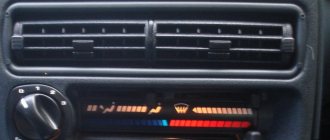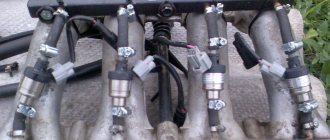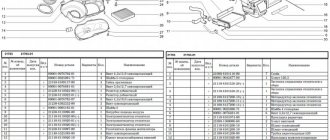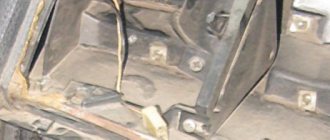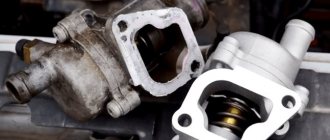Many VAZ-2115 owners have problems with uneven heating of the interior. Namely, when cold flows blow onto the windshield from the side air ducts, and hot flows from the air ducts located in the center of the dashboard. This becomes especially noticeable when the temperature of the heating system decreases. You can solve this problem yourself quite simply. We will tell you how to adjust the heater dampers on a VAZ-2115 in this article.
The design and principle of operation of the VAZ 2114/15 stove
The heating system of the VAZ 2114/15 is designed to heat the air entering the passenger compartment. Its design is the same in cars with injection and carburetor engines. The coolant heated by the engine flows from the cooling system into the heater radiator, which is blown by a fan. The flow of warm air created in this way enters the cabin through the air duct system. The intensity and direction of air flow is regulated using deflectors and dampers. The interior heating system of the VAZ 2114/15 can operate in several modes.
What to do if the stove in the car does not heat well
If the stove in the car does not heat well or does not work at all, then you first need to determine the cause of the malfunction and then eliminate it. Most problems with a car heater manifest themselves as follows:
- The stove in the car does not heat well;
- The heater in the car blows cold air;
- The stove in the car sometimes works, sometimes it doesn’t (it blows either cold or hot air);
- The air from the stove in the car is quite hot, but it blows weakly;
- The heater in the car does not work (does not turn on).
In the table below, we have combined the possible reasons for the malfunction of the car's interior heating system, described how they can affect the operation of the stove, and listed ways to eliminate them.
| Possible cause of stove malfunction | Symptoms of a malfunction | Remedies |
| Air in the interior heating and engine cooling system | 1. The stove does not heat well; 2. The stove blows cold air; 3. The stove blows either cold or hot air. | 1. Remove air from the system (simple method here); 2. If air is not removed or appears again, check whether the cylinder head gasket is broken. |
| Thermostat stuck open | Check the thermostat, if a malfunction is detected, replace it with a new one. | |
| Heater radiator clogged | 1. The stove does not heat well; 2. The stove blows cold air. | 1. Vacuum the surface of the radiator; 2. Flush the engine cooling system; 3. If all else fails, replace the radiator. |
| Problems with the heater valve or air damper controls | 1. Check whether the cable has come off the damper control levers or the heater tap; 2. If the heater tap is faulty, it must be replaced. | |
| Cabin filter clogged | 1. The air from the stove is quite hot, but it blows weakly. | Replace the cabin filter. |
| The fan is not blowing well | Contact a specialist (auto electrician) to determine the causes of the malfunction and eliminate them. | |
| The fan does not turn on | 1. The stove in the car does not work (does not turn on); 2. The air from the stove is quite hot, but it blows weakly and only at high speed. | |
| Problems with the stove control unit | 1. The stove does not heat well; 2. The stove blows cold air; 3. The stove blows either cold or hot air; 4. The stove does not work (does not turn on). |
If the stove heats the interior to 16 degrees from below and up to 10 degrees from above in severe frost outside, then it can be considered working. But in order to avoid unwanted problems and to warm up the car well, it is recommended to take preventive measures in a timely manner to ensure the correct operation of the heater. It should be remembered that the longer the car’s service life, the more attention its heating system requires.
Stove design
The VAZ 2114/15 stove consists of the following elements:
- Fan.
- Windshield defroster.
- A distribution flap that directs air flow to the central and side deflectors, to the lower and upper parts of the cabin.
- Control valve.
- Stove radiator.
- Duct that directs air flow to the legs.
- Internal air duct.
Poor windshield airflow
One of the problems with the ventilation and heating systems of VAZ models is poor airflow through the windshield. Many owners, complaining about design flaws, try to make modifications or turn to service center specialists for help. However, in most cases, if the windshield blows poorly, the problem is not some kind of defect, but a simple adjustment.
As practice shows, weak windshield airflow is primarily caused by the damper. More precisely, all the problems are due to the fact that the damper control cable has become loose or has fallen off the lever. It just needs to be pulled up or put in place.
Adjusting the windshield defogger system
As we said above, in order to ensure normal airflow on the windshield of Kalina or another VAZ model, you must first check the tension of the damper control cable. To do this, you will first have to remove the left screen of the dashboard, having first unscrewed all the mounting bolts.
If you see that the cable tension is not enough to completely close the damper, you need to shorten it a little. We will need an awl and wire cutters. First you need to remove the bracket. Along its edges there are semicircular cutouts, into one of which we insert an awl and carefully remove the tip from the end of the cable. Then, using wire cutters, we bite off one turn, and then twist the remaining part. After this, we thread the end of the cable back.
To make sure that the actions are correct, we test the operation of the windshield blower. Turn on the stove and control the airflow. If the air flow is weak and cold, you can repeat the procedure and bite off another turn of the cable tip.
Note. You should not immediately bite off two or more turns of the end of the damper control cable. You can overdo it and ruin everything. It's better to do everything gradually.
After completing the cable tension adjustment, install the panel in the reverse order.
Modification of the windshield blowing system of VAZ-2113 (2114, 2115)
Almost every Samara owner complains about uneven airflow in the cabin. This is primarily expressed by the fact that hot air flows from the central air ducts (from the dashboard) to the windshield, and a cold flow comes from the side nozzles. This situation manifests itself most clearly when the heater temperature decreases when the control lever is moved to the left.
Heater fuse and reasons for its failure
Often the cause of malfunction of most components and systems of a car is a blown fuse. The stove is no exception. Failure of a 30A heating system fuse causes the fan motor to stop and air to stop flowing into the cabin. In this case, find an element marked F7 in the fuse block and replace it. The new fuse should also be rated 30A. If the fan does not work after this, the problem should be looked for elsewhere.
It is often difficult to determine that it is the fuse that has blown. It can fail due to a short circuit in the electrical wiring, a malfunction of the electric motor, severe clogging of the cabin filter and in a number of other situations. The difficulty lies in the fact that fuse F7 is simultaneously included in the rear window heating electrical circuit and is responsible for the cigarette lighter, glove compartment lighting and headlight washer motor. If it fails, all these components will not work.
Malfunctions and their solutions
Heater motor problems
It is best to start looking for a problem with the heating system if the stove blows cold air 2115 The fact is that in front-wheel drive VAZs, the heater motor most often fails. In order to check its functionality, you should activate the ignition and start the engine. The functionality of the heater motor must be checked on the control unit in all possible positions. At the moment of switching the turntable, the motorist should not hear the sound accompanying the change in speed.
However, among other things, you should pay attention to the operation of the electric motor at maximum speed. If any shortcomings are heard, then the problem may be hidden in a faulty resistor.
If the motor burns out completely or partially, it must be replaced. The reasons that led to the replacement of the electric motor should be eliminated using the recommendations described below:
- First of all, it is necessary to dismantle the decorative trim located on the interior side, then disconnect the black-blue motor wire that powers the device, and get rid of the ground mount.
- After opening the hood, you need to remove the wiper arms and unscrew the frill fasteners. The next step will rid the car of the rubber seal.
- The upper casing of the device can be removed by unscrewing four screws. Then it is important to pull the power wires of the electric motor through the seal, which will allow you to remove the unit itself (the housing will have to be divided in half).
- Once half of the housing with the faulty electric motor has been removed, you can begin to remove the assembly itself.
Further actions include the need to install a new working unit and return the removed parts to their original place.
Airlock
If the heater does not blow due to the presence of an air lock in it, then the motorist can independently get rid of it using several simple and accessible methods. The simplest option is to position the vehicle on a hill with the front part forward. Then the car owner will have to open the expansion tank, fill it with coolant to the maximum value, activate the engine and warm it up to operating temperature, while maximizing the speed to 3000. After this, the pipe located at the bottom should be drained, carefully pulling it off so as not to burn your hands. The expansion tank cap must not be closed. After the air that escapes, antifreeze will begin to flow, which will have to be added periodically. After not a single bubble appears when exposed to the pipe, when the heater is turned on, the interior space of the cabin will begin to fill with heat.
Almost all front-wheel drive vehicles of the domestic manufacturer (VAZ) are equipped with high-quality stove heaters that will not allow passengers and the driver to freeze even in severe frost. However, despite this circumstance, it happens that the stove blows cold air. There can be many reasons why VAZ cars are not warm enough during the cold season.
Cold air can only appear at idle, but at the same time, during active movement, the car interior will warm up well. Therefore, if the VAZ-2115 stove does not heat well, you should start solving the problem by troubleshooting, sequentially diagnosing all components of the car.
Why the stove does not work or does not heat the air
If the stove fails, it either does not work at all, or it works but does not heat the air. In the first case, first check the fan wiring, starting with fuse F7. If the fuse is blown, replace it. Then they check the relay, which may not turn on the first time or only when the engine is warm. In this case, the relay is replaced with a new one.
Then the serviceability of the electric motor is assessed. To do this, power is directly supplied to its contacts from the battery. If the electric motor starts to operate at maximum speed, then it is in good condition. Otherwise, it will need to be repaired or replaced.
Heater dampers don't work
The distribution of air flows throughout the cabin is carried out by dampers, which, in turn, are controlled using cables. When these cables fail, problems arise with directing the air flow to the windshield or to the foot area. In addition, the damper that blocks the flow of air from the street begins to work incorrectly. In this case, adjustment of the damper drives is required.
Such situations can arise even on a new car. Slightly warm air begins to flow from the lower, upper and side deflectors, and hot air begins to flow from the center console. This is due to the poor build quality. There are gaps between the joints of the air ducts and the dampers, which leads to warm air entering only from the center console and heating the panel from the inside.
The drive cable is always taut. Therefore, over time it bends, breaks off or stretches. In this case, it is necessary to adjust the damper drive, which is performed in the following order:
- In the stove, we look for a bracket with which the cable sheath is held on the heater body.
- A galvanized metal lever located on the left side is pulled back. This position corresponds to the maximum opening of the damper.
- The length of the cable is tightened and adjusted. The long lever on the lever block in the extreme right position should open the damper completely.
- After adjustment, the cable is securely fixed.
Symptoms of a problem
Many car owners who operate VAZ family cars complain about the build quality of the heating systems of domestic cars. Often, a completely new vehicle turns out to be simply crammed with a lot of flaws and defects.
Among the frequently encountered ones are the following: when the stove is operating, hot air is supplied exclusively through the central openings, while a slightly warm breeze blows from the side deflectors - both upper and lower. As a rule, this indicates that the air ducts were poorly assembled on the conveyor. As a result, large gaps remained between them and the dampers. In this case, you will have to adjust the rods. In this case, most likely, you will need to disassemble the instrument panel to gain access to them.
Problems with the dampers, in turn, lead to the fact that you have to wait a long time for the windshield to thaw.
The list of other possible failures and the reasons that led to them is as follows:
- at idle almost cold air comes in - the pump is faulty or the heater radiator is clogged;
- cold pipes (including those blowing into the feet) - the thermostat is jammed, the heating tap does not open;
- side deflectors supply unheated air - problems with dampers and rods.
Experienced auto mechanics recommend installing a similar suitable unit from a foreign car instead of the “native” fan. This usually significantly improves heating efficiency.
As a preventative measure, you should also ensure that antifreeze is filled in the required quantity at all times. Don’t forget about the need to regularly ventilate the radiator.
Why is antifreeze leaking from the stove?
A coolant leak in the heating system can occur from:
- stove radiator;
- stove tap;
- stove pipes.
If a coolant leak occurs from the radiator, it is usually replaced with a new one. Repairs to restore tightness are usually complex and labor-intensive. In addition, if the radiator has been in use for a long time, its tubes become clogged with deposits and dirt, and, as a result, heat transfer decreases.
The valve opens and closes the coolant supply to the radiator, thereby regulating the heat in the cabin. Over time, it may begin to leak, as evidenced by the characteristic smell of antifreeze in the cabin, a puddle on the floor on the passenger side and a decrease in the coolant level in the expansion tank. The faucet cannot be repaired and in such cases is replaced entirely.
If the heater radiator begins to leak, it is usually replaced with a new one. The reason for coolant leakage from the pipes is usually their wear - the rubber ages and cracks over time. When diagnosing a problem, you need to wipe the suspected leak areas with a rag and observe the outlet and inlet pipes on a warm engine. Worn hoses are always replaced with new ones.
The stove makes a hum, whistle, murmur
The cause of uncharacteristic sounds (whistle, hum, murmur, etc.) from the heater is usually a faulty electric motor. Lack of lubrication, contamination, wear of bearings and bushings - all this leads to the fact that the motor begins to whistle. It is removed, disassembled and cleaned, and the rubbing elements are lubricated. If the bearings are heavily worn, the motor will not make a whistle, but a hum. In such a situation, lubricant may not help, and the electric motor will need to be replaced.
Steam is coming from the stove
Sometimes steam starts coming out of the stove. The reason for this is a leak in the heater core. The leaking coolant hits the hot radiator housing and begins to quickly evaporate, and the smell of antifreeze appears in the cabin. To fix the problem, you will need to disassemble the stove and replace the heat exchanger.
Sometimes white steam comes from under the hood and enters the cabin. This happens when antifreeze gets on the hot manifold or exhaust system pants. In this case, you will need to find the location of the leak and fix it. The most common cause is damaged pipes.
How to disassemble the VAZ 2114/15 stove
The stove on the VAZ 2114/15 is located in an extremely inconvenient place. To dismantle and disassemble it you will need:
- Phillips and slotted screwdrivers with short and long handles or a screwdriver;
- set of wrenches;
- container and rubber hose for draining coolant;
- rags, a piece of oilcloth.
Dismantling the stove radiator
Dismantling the heater radiator is carried out in the following order:
- When the engine is cold, the coolant is drained.
- The screw located behind the plastic plug is unscrewed.
- The glove compartment is dismantled. To do this, first remove the lower part, and then the cover with the lighting lamp. Then the six screws securing the upper part are unscrewed. With a slight push and turn, the top of the glove compartment lowers and pulls out.
- The plug is removed from the cigarette lighter socket and the power connectors of the radio are disconnected. The radio is removed from its seat.
- The connectors on the console that interfere with its complete dismantling are disconnected. The connectors are marked for ease of subsequent assembly.
- The ashtray illumination block is disconnected.
- Two self-tapping screws are removed from the diagnostic connector. The center console is removed.
Causes of malfunction of the VAZ-2115 heater
Since a motorist may not detect the problem immediately, for example, when using the stove only in winter, there may be many reasons why the problem arose. Most often, car owners are faced with a non-working heater motor, a dirty radiator, and the presence of air pockets. Less commonly, problems occur due to a burnt head gasket or a non-functioning heater tap.
The reasons why the heater on a VAZ-2115 does not work may be a simple lack of antifreeze in the radiator or a low performance of the water pump.
Replacing and connecting the stove
Installing a new heater radiator is done in the reverse order. When installing rubber hoses, it is recommended to treat them with sealant. When connecting electrical connectors, use the markings applied during disassembly.
After assembly, coolant is poured into the system. To prevent an air lock from forming, remove the hose from the throttle assembly after loosening the clamp. Antifreeze should be poured into the expansion tank slowly, observing the disconnected hose. As soon as coolant flows out of it, the hose should be put back on the fitting and tighten the clamp. If everything is done correctly, the operation of the stove will not cause any complaints.
When installing a new heater radiator, it is recommended to pre-treat the pipes with sealant
Video: dismantling the VAZ 2114 stove
Useful video
You can glean additional interesting information from the video below:
Main reasons
To quickly troubleshoot the problem, you must know the main reasons why the VAZ-2114 stove does not heat well. There are several options here:
- The fan does not start. For example, you press the fan button, but the device does not start. There are several reasons for this phenomenon:
— the fuse through which voltage is supplied to the stove has blown (usually F7 at 30 A). Please note that the headlight washer, cigarette lighter, heated rear window and the light in the glove compartment are also powered through it;
- The ignition relay did not work. If the stove turns on only when “hot”, then the problem is in the relay. In this case, it is enough to replace it;
— low quality of contact connection in the mounting block (for example, oxidation);
— failure of the additional resistor (in this case, the stove only works when switched to the third position);
- Thermostat failure. If the thermostat breaks down, the coolant constantly circulates in a maximum circle (through the radiator) and takes a long time to heat up to the required temperature. In this case, the thermostat may need to be replaced or repaired.
- The appearance of air. Often in VAZ-2114 cars the stove does not heat well due to the formation of an air lock. How is this possible? When the engine is stopped, the coolant temperature begins to decrease. In this case, air enters the upper compartment of the radiator, which inevitably ends up in the thermostat. What's next? In the morning, suspecting nothing, you insert the key into the ignition and start the engine. The pump begins to actively circulate air that enters the heater radiator.
OVEN DOES NOT HEAT AT IDLE (COLD AIR)
Fixing this problem is quite simple. First, warm up the engine to the optimal temperature and turn it off. Now unscrew the coolant pipe clamp attached to the throttle assembly. As soon as antifreeze comes out of the tube, return the tube to its place and tighten the clamp.
- Faucet malfunction. It happens that the stove faucet does not open completely for various reasons. As a rule, in 9 out of 10 cases this breakdown is the cause of the problem. What to do in this case? It is enough to tighten the cable a little. In this case, it is advisable to do this from the accelerator pedal. Take pliers and use them to increase the tension.
There are situations when the faucet does not open at all. Making great efforts is very dangerous, because it can lead to serious damage to the stove and a real flood in the cabin. If you feel that the faucet does not give in, it is better to change it immediately.
- A clogged radiator is another common problem that can cause a stove failure or poor heating. Everything is simple here - remove the radiator and blow it out until it is completely clean. If this does not help, then the only option is replacement. To do this, you need to remove the glove compartment and unscrew the fastener from the left side of the panel. After this, the assistant pulls the panel towards you, and you remove the radiator.
- Problems with the fan impeller. There are situations when the radiator gains temperature, but warm air still does not enter the cabin. In this case, one of the reasons may be the impeller.
- Poor quality radiator. Sometimes the manufacturer simply saves money and installs the most budget-friendly version of the device on the car (for example, Ukrainian-made). In such a situation, it is better to immediately replace it and install a higher-quality DAAZ radiator.
- The pump does not perform its function. Some car enthusiasts notice that the stove stops working only at idle (although when driving there are no problems with the quality of heating). If you are faced with the same situation, then the pump is most likely faulty.
In this case, the circulation of the liquid is disrupted, the flow is too weak, and the efficiency of the stove decreases significantly. Similar problems can arise when the coolant level decreases. In this case, it is better not to save money and install a high-quality pump made of duralumin. As a manufacturer, the best option is Belmag. You can also install “HEPU”, but you will have to run a lot to find a truly original one, and not an ordinary fake.
- Decrease in coolant level. We have already mentioned in the previous paragraph that the volume of coolant and the operation of the stove are interconnected. So make sure that the antifreeze level is somewhere around o at all times.
- Problem with the cylinder head gasket. If the gasket is burnt, then the aroma of the coolant will certainly be mixed with gasoline and exhaust. Another symptom of head gasket problems is thick white smoke coming from the exhaust.
- Cabin filter. Don't forget to change your car's cabin filter from time to time. If it becomes clogged, the quality of the stove’s operation will deteriorate significantly. Making a replacement takes just a few minutes. To do this, you need to lift the hood, dismantle the old housing and remove the worn filter. After this, install a new filter and reassemble everything in reverse order.
Sources:
https://vazauto-club.ru/mashina-2115-pechka-ne-greet-na-xolostyx/ https://www.nn.ru/community/auto/vaz/na_kholostykh_ne_greet_pechka_mashina_vaz_2115.html https://avtoshkolak.ru /raznoe/na-holostyh-oborotah-ploho-greet-pechka-2114.html https://auto-machina.ru/raznoe/na-holostyh-oborotah-ploho-greet-pechka-2114.html
Fan motor repair
If the electric motor malfunctions, it should first be removed and then the feasibility of repair should be determined. It is necessary to evaluate the condition of the brushes, armatures, windings, and check the integrity of the wire insulation. The contact area of the brushes on the armature can be cleaned with zero grade sandpaper. You should also pay attention to the bushings and bearings - clean the rubbing parts from dirt and apply lubricant (for example, Litol). All elements with signs of wear must be replaced.
Heater radiator repair
Usually, if mechanical damage is detected, the stove radiator is replaced with a new one. However, some car owners try to repair cracks and holes using soldering. A copper radiator is quite easy to solder, and it is much easier to restore than an aluminum one. To repair an aluminum heat exchanger, you will need special flux and tinning solder, as well as a powerful soldering iron. The damaged area is first cleaned of dirt and degreased. Then flux and solder are applied to it with a soldering iron. After soldering, it is recommended to check the radiator under pressure to make sure there are no leaks.
Design of heating radiators from LUZAR
LUZAR heating radiators are available in three types:
- Tubular-plate, prefabricated, aluminum. It consists of aluminum plates through which aluminum tubes pass, inside which coolant runs. The tanks on such radiators are made of plastic. Heater radiators of this type are used for heating small-sized salons due to limited heat transfer; have the best rigidity and light weight, as well as the lowest price.
- Tubular-tape, non-assembled (brazed), aluminum. The corrugated aluminum tape in such a radiator is located between aluminum flat-oval tubes. Radiator tanks of this type can be made of either plastic or metal. The design of non-assembled (brazed) aluminum devices is the most universal, allowing the creation of heat exchangers with any specified characteristics. Aluminum stove radiators are light in weight and relatively high rigidity, as well as at optimal prices.
- Tubular-tape, non-assembled (soldered), copper-brass. The design is very close to type 2 - between the copper flat-oval tubes there are copper strips folded in the form of an “accordion”. At the same time, the tanks on such heating radiators are made of brass - in order to increase the overall rigidity of the structure. Copper heating radiators - due to the high specific heat capacity of copper - have excellent heat transfer rates. However, due to the high softness of copper, heating radiators made of this metal are forced to have a narrow tube and a large interval (step) between the tubes, which imposes serious limitations on maximum efficiency. Also, copper heater radiators have the highest cost and the lowest rigidity to torsion, fracture and internal pressure. In this regard, copper heater radiators are “outdated” and are gradually falling out of use.
LUZAR: time-tested and road-tested
LUZAR radiators have been awarded the “Radiator of the Year” award several times. For several reasons:
- Our products are not inferior to the original ones in quality and durability.
- Often it is our products that are “original”.
- We provide a warranty of 2 years or 125,000 kilometers.
- We check each model for leaks, and several models of each batch for corrosion and vibration resistance.
- You can buy stove radiators in all possible ways (more details in the “Where to buy?” section)
- We answer all customer questions openly and quickly
Make sure of this by calling 8-800-555-8965.
Cleaning and flushing the radiator of the VAZ 2114/15 stove
You can increase the efficiency of the stove by cleaning and flushing the radiator. The procedure can be performed without dismantling the radiator or with dismantling it. In the first case, you will need to remove the outlet and inlet pipes from the heater and pour a cleaning solution into it. Citric acid, plumbing cleaners (for example, “Mole”), etc. are used as such a solution. Then the radiator is washed with running water and coolant is added. You can clean the radiator better by removing it from the car. This will allow you to wash it not only from the inside, but also from the outside, removing dirt between the honeycombs. Washing is usually carried out with running water.
If after performing these procedures the stove does not work better, the radiator must be replaced.
